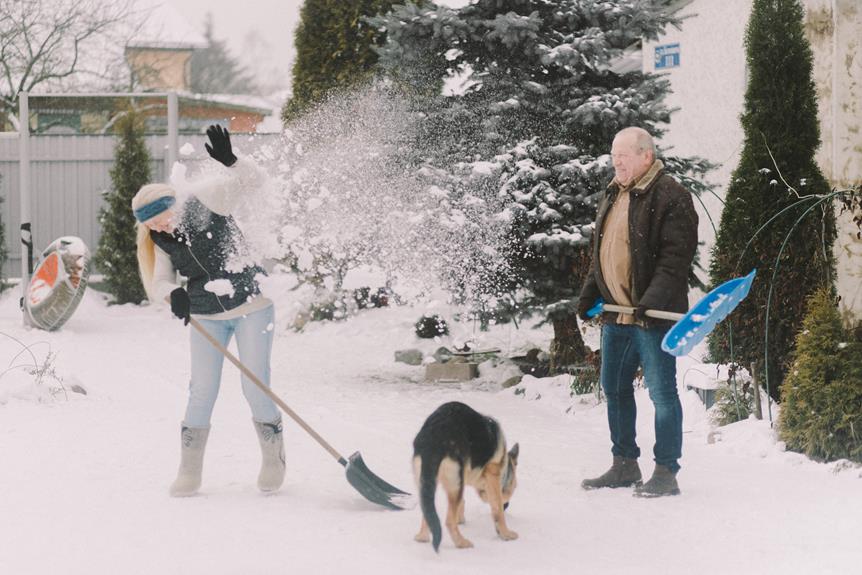Navigating the intricate process of duct cleaning in Mississauga during the winter months presents a host of challenges that demand careful consideration and strategic planning.
From the risks of indoor duct surface freezing to the complexities of sealing off exterior air infiltration, the task requires a meticulous approach to ensure efficiency and maintain indoor air quality standards.
As the winter elements pose unique obstacles to the cleaning process, understanding the specific protocols and strategies employed becomes imperative in safeguarding against potential contamination and ensuring a healthy living environment for residents.
Key Takeaways
- Winter duct cleaning requires specialized gear to combat freezing conditions.
- Prevent indoor duct surface freezing by managing moisture and temperature.
- Seal off exterior air infiltration to maintain indoor air quality and efficiency.
- Implement stricter containment measures to prevent contamination during cleaning.
Winter Challenges for Duct Cleaning
Winter duct cleaning presents unique challenges due to the freezing temperatures and snow accumulation that hinder access to HVAC components and increase the risk of structural damage.
Equipment maintenance is crucial during winter operations to ensure optimal functionality despite the harsh conditions. Regular checks and lubrication of moving parts become even more critical to prevent malfunctions caused by the cold.
Temperature regulation is a key aspect, requiring specialized equipment to maintain suitable working conditions for both the cleaning team and the HVAC system. Monitoring and adjusting the temperature inside the cleaning area is vital to prevent freezing of essential components and guarantee efficient operation throughout the winter duct cleaning process.
Risks of Indoor Surface Freezing
Amidst the challenges posed by freezing temperatures and snow accumulation during winter duct cleaning, an important consideration lies in understanding the risks associated with indoor duct surface freezing. When temperatures drop, several risks emerge, affecting both the efficiency of the cleaning process and the structural integrity of the ductwork.
These risks include:
- Preventing Condensation: High-powered vacuum systems can accelerate evaporation in ducts, leading to condensation that may freeze on the surfaces.
- Structural Integrity Concerns: Sub-zero temperatures can cause freezing of residual moisture, potentially leading to cracks in the ducts and compromising their structural integrity.
- Fibrous Insulation Risks: Freezing temperatures can cause fibrous insulation to contract and detach, posing a risk to the joints and overall system integrity.
Strategies to Seal Air Infiltration
Efficient containment of exterior air infiltration is crucial for maintaining the integrity and effectiveness of the HVAC system during duct cleaning operations. To achieve this, insulation barriers play a key role in preventing air leakage and maintaining temperature consistency within the ductwork.
In addition, sealing registers and closing vent dampers help minimize air infiltration, especially when dealing with pressurized ductwork systems. Adding plastic sheeting over duct terminations further enhances the containment of air within the system.
Containment Protocol Essentials
To enhance containment measures during duct cleaning operations, utilizing additional specialized gear is essential for minimizing air drafts and maintaining a controlled work environment. When dealing with winter conditions, reinforced containment becomes crucial. Winter insulation plays a key role in preserving the integrity of the work area and preventing external elements from interfering with the cleaning process. In this context, contractors should consider the following essentials:
- Heavy-duty construction zippered curtains for enhanced containment.
- Portable electric heaters or forced-air blowers to ensure a comfortable work environment.
- Reinforced weatherproofing tapes to seal indoor access points effectively.
Importance of Containment Measures
The implementation of stringent containment measures is paramount in ensuring the effectiveness and success of winter duct cleaning operations. During winter insulation, it is crucial to prevent airborne contaminants from spreading throughout the property. Proper containment measures help maintain air quality and prevent the circulation of dust, debris, and other pollutants.
By sealing off the work area with winter-specific containment provisions like heavy-duty construction zippered curtains and insulating blankets, the risk of contaminants escaping into living spaces is significantly reduced. These measures also help protect against the infiltration of freezing outdoor air, ensuring that the cleaning process is carried out efficiently and without compromising indoor air quality.
Containment precautions play a vital role in maintaining a clean and healthy environment during winter duct cleaning.
Parking Constraints in Cold Weather
During winter duct cleaning operations, the challenges posed by parking constraints in cold weather can significantly impact the efficiency and safety of the process. Snow removal becomes a crucial task to create suitable parking spaces for equipment and vehicles. Parking solutions need to be established to prevent the obstruction of snow removal operations and ensure smooth access to the cleaning site. Implementing designated parking areas and coordinating with snow removal services are essential steps to mitigate the impact of parking constraints.
- Snow removal
- Parking solutions
Ground-Bearing Weight Issues
As winter duct cleaning operations face challenges related to parking constraints in cold weather, one critical issue that arises is the inadequate ground-bearing weight capacity for equipment placement and stability during the cleaning process.
Snow removal becomes essential to ensure a firm foundation for the equipment. The accumulation of snow can reduce the ground-bearing capacity, potentially leading to sinking or instability of the cleaning apparatus. Proper snow removal techniques are crucial to prevent these issues and maintain equipment stability.
Additionally, ensuring that the equipment is placed on solid ground and utilizing stabilizing mechanisms can help mitigate the risks associated with ground-bearing weight limitations during winter duct cleaning operations.
Difficulties With Accessing HVAC Components
Accessing HVAC components in winter poses significant challenges due to the obstruction caused by tall snowbanks. The snow accumulation around these components creates accessing obstacles that can impede the cleaning process. Snowbank clearance becomes crucial to effectively reach and service the HVAC system. To mitigate these difficulties, professionals need to employ specialized techniques and equipment to ensure thorough cleaning and maintenance.
Challenges with Accessing HVAC Components:
- Limited visibility and accessibility due to snowbanks
- Increased risk of slipping or falling on icy surfaces
- Time-consuming snow removal to reach components
Preventing Contamination in Living Spaces
Snow accumulation around HVAC components in winter increases the risk of contamination in living spaces, necessitating strict containment measures to prevent the spread of airborne particles during duct cleaning procedures.
Indoor air quality is crucial, and preventing contamination is paramount to maintaining a healthy living environment. By implementing effective containment protocols, such as sealing off areas undergoing cleaning and using specialized equipment to minimize the escape of particles, the risk of contamination can be significantly reduced.
Contaminants like dust and debris can easily circulate into living spaces if proper precautions are not taken. Therefore, ensuring that stringent containment measures are in place is essential for safeguarding indoor air quality and preventing the spread of contaminants throughout the home.
Frequently Asked Questions
How Can Homeowners Prepare Their Homes for Winter Duct Cleaning to Ensure a Successful and Efficient Process?
To prepare for winter duct cleaning, homeowners should conduct an insulation inspection, implement safety precautions, enhance weatherproofing, and optimize airflow. By ensuring a well-sealed environment, efficient cleaning processes can be achieved with minimal disruptions.
Are There Any Specific Techniques or Tools Used to Prevent Freezing of Duct Surfaces During Winter Cleaning?
Insulation techniques are crucial to prevent freezing of duct surfaces during winter cleaning. Employing advanced sealing methods and insulation barriers can effectively maintain duct surface temperatures above freezing point, preventing structural damage and ensuring optimal air quality.
What Are Some Common Mistakes Homeowners Make When Trying to Seal off Exterior Air Infiltration During Duct Cleaning in Winter?
Common mistakes homeowners make during winter duct cleaning include inadequate insulation, improper weather stripping, and inconsistent temperature regulation. These errors can lead to air leakage, reduced energy efficiency, and potential damage to HVAC systems.
How Can Portable Electric Heaters or Forced-Air Blowers Be Effectively Used to Maintain Comfortable Living Conditions During Winter Duct Cleaning?
Portable electric heaters and forced-air blowers are vital tools for maintaining comfort during winter duct cleaning. They provide energy-efficient heating options, ensuring indoor air quality and ventilation solutions. Proper use optimizes conditions, improving efficiency and ensuring a comfortable environment.
What Are the Potential Consequences of Not Implementing Stricter Containment Measures During Winter Duct Cleaning, Especially in Terms of Air Quality and Health Risks for Residents?
Failure to implement stricter containment measures during winter duct cleaning can lead to compromised air quality and increased health risks for residents. Contaminants escaping work zones due to lax containment can circulate into living spaces, affecting occupants' well-being.
Conclusion
In conclusion, winter duct cleaning in Mississauga presents numerous challenges that demand meticulous planning and execution.
From risks of indoor surface freezing to parking constraints and difficulties in accessing HVAC components, strategic containment measures are essential to ensure a clean and healthy environment for residents.
By implementing effective strategies to seal air infiltration and prevent contamination in living spaces, maintaining indoor air quality becomes paramount.
Precision in planning and execution is key to overcoming obstacles and achieving optimal results.

